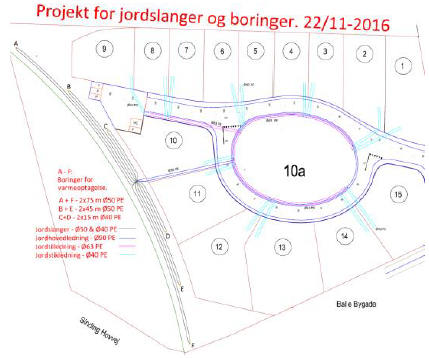Cold District Heating with thermonet - a demonstration project in Silkeborg, DK
5G network

Picture credits: Klimadan / Silkeborg Forsyning
Facts at one glance
Status of the project:
Commercially operating
Operation mode:
Heating network
Geothermal source:
Shallow / Ambient Geothermal
Max heat capacity:
< 1MW
Network generation:
5G
Year of operation start:
2018
Contact:
kontakt@termonet.dk
Description of the project
The project "Cold District Heating" was initiated to demonstrate the operation of thermonet, a geothermal heating network owned by a utility company.
It was established in 2017 as part of a new housing construction, where the houses were continuously connected for the project to be ready to operate in 2018. The goal was for the residents to have low-cost collective heating-supply on a par with district heating.
A total of 15 houses are connected to the geothermal heating network. The heating network consists of unisolated plastic pipes, transporting the brine with an average temperature of 8 degrees Celsius. There has been drilled 6 vertical geothermal boreholes of 120 meters depth each, with the main pipes connected in a well.
Each supplied household ass a seperate electricity meter only for the electricity usage of the heat pump. The heat supply in each household is measured by two heat meters, the data of which are accessed daily by the operator.
Highlights of the project
- The operational monitoring of the system gives the clients improved sense of security.
- It can be an advantage to the operation and communication of the system, that the operator owns the heat pumps.
The biggest challenges / obstacles
- Initially there were challenges concerning air in the brine system, which were solved by venting.
- Design requirements in environmental legislation can have an influence on the investment costs. As for this case, it turned out that the project were to be approved according to the Environmental Protection legislation, rather than the Geothermal Order as first anticipated.
- The brine pipes were laid with a distance of 1 meter, which resulted in greater costs of digging. Less of a distance between the pipes, for instance 30 cm, can minimise the costs.
- The number of electricity meters in each household includes relatively high costs.
- Cooling is not possible with individual air-to-water source heat pumps, however it is possible with the geothermal heating network.
Detailed characteristic of the project
Site description
Address
Balle Bygade, 8600 Silkeborg, Denmark
Status of the project
Commercially operating
Year of operation start
2018
Type of geothermal Heating / Cooling network
Heating network
Type of geothermal technologies involved
Shallow / Ambient Geothermal
Are heat pumps used within this project?
yes - located at the clients
Heating network generation
5G
Number of clients supplied
10 - 100
Depth range
1-120
Involved companies
Owner / operator
Silkeborg Forsyning
Planner / installer
PlanEnergi / Klimadan
Driller
GeoDrilling
Types of used geothermal sources
Source
Depth range
Temperature range
Purpose
Soil/rock - closed loop
< 20 meters
< 20°C
Heat extraction
Soil/rock - closed loop
< 20 meters
< 20°C
Heat extraction
System design
Heat sources included in the network
Monovalent - geothermal energy is the only heat source
Max heating capacity supplied by geothermal energy
< 1MW
Share of geothermal energy
60% - 70%
Annual operation hours for heating
2000 hours - 4000 hours
Annual heating production
< 1 GWh
Annual heating production share
60% - 70%
Energy conversion factor linked to the use of geothermal energy
< 5
Heat source for peak load supply
Geothermal
Has backup system?
Yes
Backup system
Electricity
Share of fossil fuels for annual gross heat production
0 %